What is Algorithms
- Algorithm
- Named after a Muslim mathematician, Al-Khawarzmi
(عَبْدَالله مُحَمَّد بِن مُوسَى اَلْخْوَارِزْمِي)
What is an Algorithms ?
- Algorithm is a well defined computational procedure that takes some value (s) as input, and produces some value (s) as output.
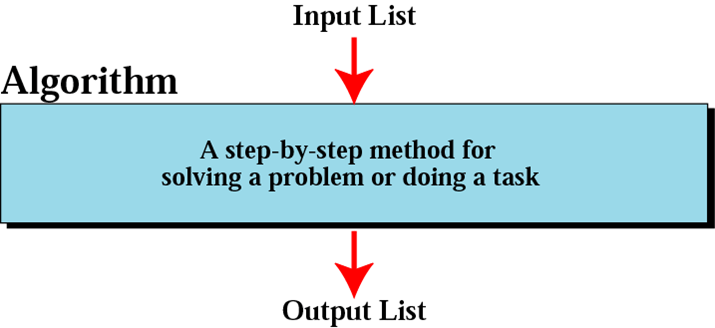
Algorithm Concepts
What is Data Structure?
A data structure is a systematic way of organizing and accessing data. Some basic data structure as follows.
- Array
- Link List
- Stacks
- Queues
- Trees
What is Program?
Program is an implementation of an algorithm in some programming language.
Data structure + Algorithm = Program
Design & Analysis of Algorithms
1.The “design” pertains to
- i. The description of algorithm at an abstract level by means of a pseudo language, and
- Proof of correctness that is, the algorithm solves the given problem in all cases.
- The “analysis” deals with performance evaluation (complexity analysis).
Problem, Solution and Tools
- A computer does not solve problems; it’s just a tool that I can use to implement my plan for solving the problem.
- A computer program is a set of instructions for a computer. These instructions describe the steps that the computer must follow to implement a plan.
- An algorithm is a plan for solving a problem.
- A person must design an algorithm.
- A person must translate an algorithm into a computer program.
Algorithm Development Process
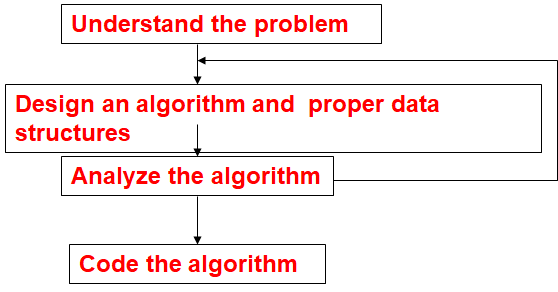
Good Algorithms?
- Run in less time
- Consume less memory
But computational resources (time complexity) is usually more important
Measuring Efficiency
- The efficiency of an algorithm is a measure of the amount of resources consumed in solving a problem of size n.
- The resource we are most interested in is time
- We can use the same techniques we will present to analyze the consumption of other resources, such as memory space.
- It would seem that the most obvious way to measure the efficiency of an algorithm is to run it and measure how much processor time is needed
- But is it correct???
Factors
- Hardware
- Operating System
- Compiler
- Size of input
- Nature of Input
- Algorithm
Which should be improved?
Running Time of an Algorithm
- Depends upon
- Input Size
- Nature of Input
- Generally time grows with size of input, so running time of an algorithm is usually measured as function of input size.
- Running time is measured in terms of number of steps/primitive operations performed
- Independent from machine, OS
Finding running time of an Algorithm / Analyzing an Algorithm
- Running time is measured by number of steps/primitive operations performed
- Steps means elementary operation like
- ,+, *,<, =, A[i] etc
- We will measure number of steps taken in term of size of input
Simple Example (1)
// Input: int A[N], array of N integers
// Output: Sum of all numbers in array A
int Sum(int A[], int N)
{
int s=0;
for (int i=0; i< N; i++)
s = s + A[i];
return s;
}
How should we analyse this?
Simple Example (2)
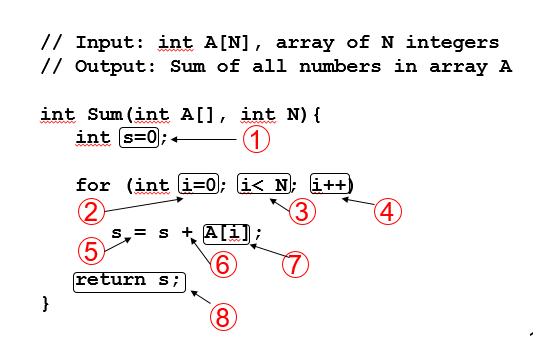
1,2,8: Once
3,4,5,6,7: Once per each iteration
of for loop, N iteration
Total: 5N + 3
The complexity function of the
algorithm is : f(N) = 5N +3
Simple Example (3)
Growth of 5n+3
Estimated running time for different values of N:
N = 10 => 53 steps
N = 100 => 503 steps
N = 1,000 => 5003 steps
N = 1,000,000 => 5,000,003 steps
As N grows, the number of steps grow in linear proportion to N for this function “Sum”
What Dominates in Previous Example?
What about the +3 and 5 in 5N+3?
- As N gets large, the +3 becomes insignificant
- 5 is inaccurate, as different operations require varying amounts of time and also does not have any significant importance
What is fundamental is that the time is linear in N.
Asymptotic Complexity: As N gets large, concentrate on the
highest order term:
- Drop lower order terms such as +3
- Drop the constant coefficient of the highest order term i.e. N
Asymptotic Complexity
- The 5N+3 time bound is said to “grow asymptotically” like N
- This gives us an approximation of the complexity of the algorithm
- Ignores lots of (machine dependent) details, concentrate on the bigger picture
Comparing Functions: Asymptotic Notation
- Big Oh Notation: Upper bound
- Omega Notation: Lower bound
- Theta Notation: Tighter bound
Big Oh Notation
If f(N) and g(N) are two complexity functions, we say
f(N) = O(g(N))
(read “f(N) is order g(N)”, or “f(N) is big-O of g(N)”)
if there are constants c and N0 such that for N > N0,
f(N) ≤ c * g(N)
for all sufficiently large N.
- T(N) = 1000 N
- F(N) = N^2 is T(N)=O(F(N))?
- 1000N > N^2 for small values of N
Let N0 = 1000, c=1
Or N0 = 10, c=1000
1000N = O( N^2) at N= N0 = 1000
1000*1000 <= 1(1000)^2
- Compare the relative growth!
- T(N)= O(F(N)) or 1000N = O (N^2)
Example (1)
- Consider
f(n)=2n2+3
and g(n)=n2
Is f(n)=O(g(n))? i.e. Is 2n2+3 = O(n2)?
Proof:
2n2+3 ≤ c * n2
Assume N0 =1 and c=1?
Assume N0 =1 and c=2?
Assume N0 =1 and c=3?
- If true for one pair of N0 and c, then there exists infinite set of such pairs of N0 and c
Big Oh Notation
- T(N) = O(f(N)) means it is guaranteed that T(n) grows at rate no faster than f(N) so f(N) is “Upper bound” of T(n)
- N^3 grows faster than N^2 so we may say that N^2 = O(N^3)
Example (2): Comparing Functions
- Which function is better?
10 n2 Vs n3

- As inputs get larger, any algorithm of a smaller order will be more efficient than an algorithm of a larger order

Big-Oh Notation
- Even though it is correct to say “7n – 3 is O(n3)”, a better statement is “7n – 3 is O(n)”, that is, one should make the approximation as tight as possible
- Simple Rule:
Drop lower order terms and constant factors
7n-3 is O(n)
8n2log n + 5n2 + n is O(n2log n)
Omega Notation
If f(N) and g(N) are two complexity functions, we say
f(N) = W(g(N))
if there are constants c and N0 such that for N > N0,
f(N) >= c * g(N)
for all sufficiently large N.
Small Omega Notation
If f(N) and g(N) are two complexity functions, we say
f(N) = W(g(N))
if there are constants c and N0 such that for N > N0,
f(N) > c * g(N)
for all sufficiently large N.
Theta Notation
If f(N) and g(N) are two complexity functions, we say
f(N) = Q(g(N))
- c1 ´ f(n) is an Upper Bound on g(n)
- and c2 ´ f(n) is a Lower Bound on g(n)
Asymptotic notation

- Example:
- f(n) = 3n5+n4 = Q(n5)
Review of Three Common Sets
g(n) = O(f(n)) means c ´ f(n) is an Upper Bound on g(n)
g(n) = W(f(n)) means c ´ f(n) is a Lower Bound on g(n)
g(n) = Q(f(n)) means c1 ´ f(n) is an Upper Bound on g(n)
and c2 ´ f(n) is a Lower Bound on g(n)
These bounds hold for all inputs beyond some threshold n0.
Some Questions
3n2 – 100n + 6 = O(n2)?
3n2 – 100n + 6 = O(n3)?
3n2 – 100n + 6 = O(n)?
3n2 – 100n + 6 = W(n2)?
3n2 – 100n + 6 = W(n3)?
3n2 – 100n + 6 = W(n)?
3n2 – 100n + 6 = Q(n2)?
3n2 – 100n + 6 = Q(n3)?
3n2 – 100n + 6 = Q(n)?
Performance Classification
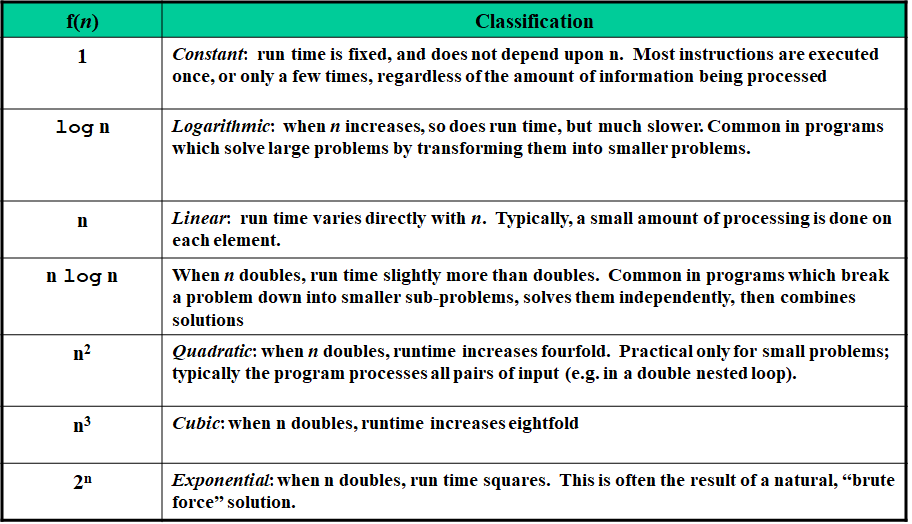
Size does matter[1]
What happens if we double the input size N?
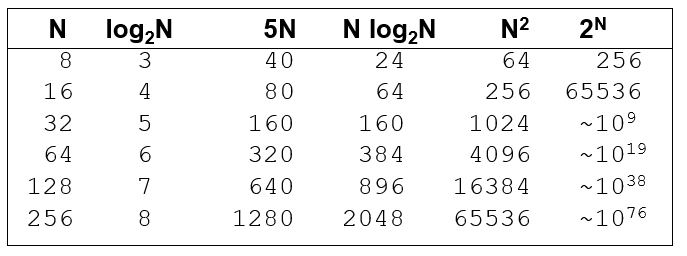
Size does matter[2]
- Suppose a program has run time O(n!) and the run time for
n = 10 is 1 second
For n = 12, the run time is 2 minutes
For n = 14, the run time is 6 hours
For n = 16, the run time is 2 months
For n = 18, the run time is 50 years
For n = 20, the run time is 200 centuries

